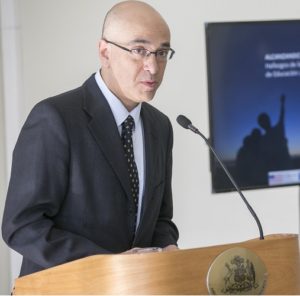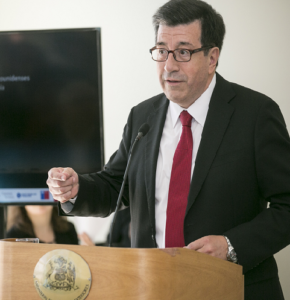AUI will present at the 247th meeting of the American Astronomical Society in Phoenix from January 4-8.
Recent News
ALMA Helps Unmask Monster Black Hole Behind Record-Breaking Cosmic Burst
Astronomers have used the Atacama Large Millimeter/submillimeter Array (ALMA) together with a suite of space- and ground-based telescopes, to study AT 2024wpp, the most luminous fast blue optical transient (LFBOT) ever observed.
Astronomers Make First Radio Detection of Rare Supernova Type, Revealing Secrets of Stellar Death
Astronomers using the U.S. National Science Foundation Very Large Array have captured the first-ever radio signals from a rare class of stellar explosion known as a Type Ibn supernova.
More than 100 experts shared their dreams, challenges, and proposals to make Chile a world power in astronomy education.
The launch of the first prospectus concerning education and the dissemination of astronomy in Chile

Ambassador Gabriel Rodriguez, Director of Energy, Science, Technology and Innovation for the Ministry of Foreign Affairs in Chile shares his thoughts on the importance of astronomy education and outreach to Chile’s future. Credit – CONICYT
In a well-attended ceremony at the Ministry of Foreign Affairs in Chile, “Reaching for the Stars: Findings of the Chile-U.S. Astronomy Education and Outreach Summit,” was officially released. The document represents the largest national effort in Chile to coordinate strategies for the promotion of astronomy education and the broader dissemination of best practices and resources; an endeavor which involved both Chilean groups and Chile’s international partners.
“Reaching for the Stars” synthesizes the ideas of more than 100 experts, representing nearly 50 Chilean and foreign institutions, who recognize the enormous potential Chile has to become a world-leader in astronomy education, and in the wider dissemination of astronomy learning opportunities for the general public. Over the past two years the U.S. Observatories in Chile and their management organizations – including AUI, AURA, Carnegie Institution for Science, NRAO, ALMA, NOAO, Gemini, GMTO, and LCO – plus the United States Embassy in Chile, CONICYT, Fundación Imagen de Chile and the U.S. National Science Foundation (NSF) all played key roles in supporting the Chile-U.S. Astronomy Education and Outreach Summit initiative.

Marianne Scott, Public Affairs Officer for the U.S. Embassy in Chile points to a strong collaboration between partners that led to a successful Summit initiative resulting in completion of the document. Credit – CONICYT
This effort is of great importance to Chile and its international partners. By the year 2025, it is estimated that 75% of the world’s astronomical observing capacity will be located in Chile. With this infrastructure, not only can we answer questions that link humanity with the universe but humankind can benefit educationally in areas of related knowledge; in particular science, technology, engineering, and mathematics (STEM), the arts, and cultural awareness. Astronomy is often seen as a “gateway science” and can be used to bring context to many other disciplines, and to inspire the next generation of STEM explorers and innovators.
Ambassador Rodriguez, Director of Energy, Science, Technology and Innovation for the Ministry of Foreign Affairs in Chile, pictured above, commented that, “Astronomy not only answers questions about the origin of life and our place in the cosmos. It is also a science that brings us closer to experiencing the transformation of ancestral mysteries into scientific knowledge; fomenting cultural knowledge and public wisdom, qualities that make all of us, inhabitants of the planet, more human.”
Astronomer Eduardo Hardy, former AUI Representative/NRAO Assistant Director for Chile, who presented the document on behalf of the U.S. observatories emphasized, “The motivation and effort of each of the national and international professionals, who generously contributed their individual experience and various points of view about the current state of astronomy education and outreach in Chile and around the world, provided the means for the identification of best practices, as well as stimulating future collaborations among those who develop astronomy learning experiences and resources.”

Eduardo Hardy delivers his comments on the relevance of astronomy EPO to the professional scientific observatories in Chile. Credit – AUI/NSF
The two Summits were seen by the participants as unique opportunities to address, as a community, the challenges of coordination and the issues of strategic planning and evaluation related to education and outreach in astronomy in Chile.

Tim Spuck, AUI’s STEM Education Development Officer, and Project Director and PI for the Summit initiative, celebrates completion of “Reaching for the Stars” at the event. Credit – AUI/NSF

Sergio Cabezon, EPO Officer for AUI/NRAO in Chile, and a Lead Editor for “Reaching for the Stars” highlights the content in the seven chapters that make up the document. Credit – CONICYT
“Reaching for the Stars” includes five chapters focusing on astronomy education and public outreach (EPO) at the national level including; astronomy learning in primary and secondary schools, and the role of planetariums/science centers and other informal science venues, the international scientific observatories in Chile, universities, and tourists/municipal observatories in astronomy EPO. Two additional chapters focus on funding and support for astronomy EPO, and program evaluation and metrics. The document overall highlights the current status of astronomy EPO in Chile and between its international partners, and presents a series of recommendations and areas for further exploration. “Reaching for the Stars” will serve as a valuable tool in Chile and abroad to improve astronomy learning for all.
Christian Nicolai, Executive Director of CONICYT commented, “We are aware that we should not just focus our activities on the supply of funds to researchers to facilitate their performance of projects at a competitive level. We must maintain an awareness of the importance and appeal which this discipline awakens in society. So, we believe that the role of astronomy in the field of science education must become a priority, a key factor for change.”

Christian Nicolai, Executive Director of CONICYT stresses the importance of astronomy education and outreach to the astronomy research community. Credit – CONICYT
In closing the ceremony, María Rebeca López, a Summit participant and teacher at Colegio Carlos Condell de la Haza in La Serena, presented the document to Luis Chavarria, Director of the Astronomy Program at CONICYT. The symbolic hand-off echoed the groups goal moving forward; CONICYT as Chile’s principal public institution enaged in the scientific field, in collaboration with Summit leaders and other key stakholders, will begin advancing the recommendations and areas for further exploration presented in “Reaching for the Stars”

Chilean teacher María Rebeca López presents “Reaching for the Stars” to Dr. Luis Chavarria, CONICYT’s Director of the Astronomy Program. Credit – CONICYT
“I am convinced that this document will be a compass for our authorities to enhance and, hopefully, prioritize astronomy as integral to our national identity.” María Rebeca López emphasized, adding, “This science, which is within reach of my students, contributes and encourages them to acquire a wider and much enriched vision of the world in which they live.”
Currently “Reaching for the Stars” is only available in Spanish, however an English language version will be made available soon. Click the links below to download high or low resolution versions of the document.
Reaching for the Stars – High Resolution
Reaching for the Stars – Low Resolution
The event was co-organized by CONICYT and the Summit Leadership Team. “Reaching for the Stars: Findings of the Chile-U.S. Astronomy Education and Outreach Summit” involved numerous contributing authors and editors. AUI’s STEM Education Development Officer Tim Spuck served as project director and PI. Sergio Cabezón (AUI-NRAO) and Valentina Rodríguez (GMTO) were lead editors on the document. Dinah Arnett (United States Embassy in Chile), Paulina Bocaz (AUI-NRAO), Eduardo Hardy (AUI-NRAO), Miguel Roth (GMTO) and Chris Smith (AURA) served as editors with assistance from David Azócar (CATA), Farid Char (University of Antofagasta), Luis Chavarría (Astronomy Program, CONICYT), Haydée Domic (Santiago Planetarium), Valeria Foncea (ALMA), Marllory Fuentes (University of Concepción), Loreto Navarrete (Verde), Leonor Opazo (NOAO-CTIO) and Mark Phillips (Las Campanas Observatory).
The following individuals are contributing authors to the document: Marcos Aracena (Collowara Observatory), Dinah Arnett (United States Embassy in Chile), David Azócar (CATA), Roberto Bermúdez (Carnegie Institution for Science), Paulina Bocaz (AUI-NRAO), Sergio Cabezón (AUI-NRAO), Farid Char (University of Antofagasta), Luis Chavarría (Astronomy Program, CONICYT), Marcos Cordero (Fundación Chile), Haydée Domic (Santiago Planetarium), Pamela Duarte (SERNATUR-Coquimbo), María Eliana Escobar (Explora Program, CONICYT), Makarena Estrella (MAS), Kadur Flores (CTIO), Valeria Foncea (ALMA), Marllory Fuentes (University of Concepción), Eduardo Hardy (AUI-NRAO), Sue Ann Heatherly (NRAO), Olga Hernández (Abate Molina School in Talca), Suzanne Jacoby (LSST), Amanda Kocz (GMTO), María Rebeca López (Carlos Condell De La Haza School in La Serena), Rodrigo Marín (Cruz del Sur Observatory), Loreto Navarrete (Verde), Leonor Opazo (NOAO-CTIO), Ana María Pérez Rivera (Andean Astronomic Observatory), Stephen Pompea (NOAO), Ed Prather (University of Arizona), Sandra Preston (McDonald Observatory), Valentina Rodríguez (GMTO y ESO), Jaime Sarah (CORFO), Juan Seguel (CTIO), Chris Smith (AURA), Jacqueline Soto (Andean Astronomic Observatory), Tim Spuck (AUI), Vilma Tapia (José Maza Sancho Scientific and Educational Institute in Antofagasta), Carola Torrejón (Likan Antai C-30 School of San Pedro de Atacama), Valeria Vera (MIM), and Vivian White (Astronomical Society of the Pacific).
For more information please contact AUI’s STEM Education Development Officer Tim Spuck at [email protected], or to join the community via social media please visit:
Reaching for the Stars Community on Facebook – https://www.facebook.com/CumbreAstronomia/
Reaching for the Stars on the Web – http://www.astroeducacion.cl/
Recent News
AUI to Attend AAS 247 Conference
AUI will present at the 247th meeting of the American Astronomical Society in Phoenix from January 4-8.
ALMA Helps Unmask Monster Black Hole Behind Record-Breaking Cosmic Burst
Astronomers have used the Atacama Large Millimeter/submillimeter Array (ALMA) together with a suite of space- and ground-based telescopes, to study AT 2024wpp, the most luminous fast blue optical transient (LFBOT) ever observed.
Astronomers Make First Radio Detection of Rare Supernova Type, Revealing Secrets of Stellar Death
Astronomers using the U.S. National Science Foundation Very Large Array have captured the first-ever radio signals from a rare class of stellar explosion known as a Type Ibn supernova.
